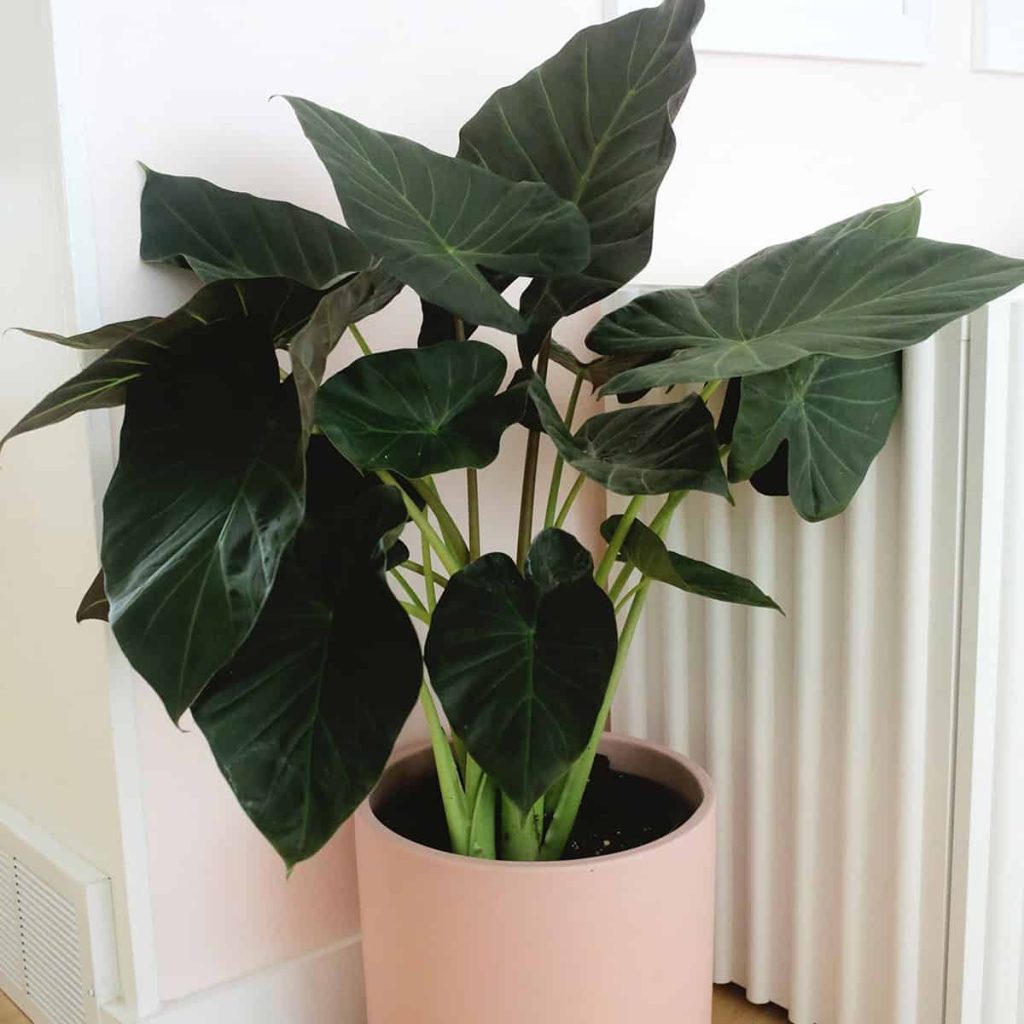
Elephant Ears (additionally know as Colocasias, Alocasias, or Xanthosoma) are heat climate vegetation with giant outsized heart-shaped leaves that resemble the ears of an elephant. Whereas the kinds of vegetation are native to totally different components of the world (South America, Central America, Asia, Africa, and Australia), they’re recognized to be easy-to-grow vegetation that thrive in hotter climates. However they can be utilized as annuals, that are dug as much as winter indoors till it’s heat once more in cooler areas.
Elephant Ears are additionally recognized for his or her fast-growing foliage and the capacity to succeed in a mature dimension in only one rising season, making them choose for fast summer season greenery or as a point of interest in a flower mattress. Fairly than conventional bulbs, Elephant Ears develop from corms (additionally referred to as “tubers”), that are a swollen underground stem that resembles a bulb and so they develop over time as they’re planted time and again.
Associated: Study to Look after Pilea Crops, Calathea, Fiddle Leaf Figs, Jade Crops, Golden Pothos, Snake Crops, Rubber Bushes, Spider Crops, Christmas Cactus, Poinsettia, Peace Lilies, Dieffenbachia, Hoya Crops, Cash Bushes, and String of Pearls Crops.


Often Requested Questions
Are Elephant Ears poisonous to pets or people?
Sure, Elephant Ears are poisonous to each pets and people, so care must be taken to put them out of attain of children or pets which may be tempted to nibble on them. It’s additionally a good suggestion to put on lengthy sleeves and gloves when pruning the vegetation because it accommodates a compound that may irritate pores and skin with direct contact.
Can Elephant Ear vegetation keep exterior within the winter?
You’ll wish to test the chilly hardiness zones for the number of plant that you just purchase as it will probably range from one plant to the subsequent. Some winter exterior in areas as chilly as zone 6 whereas others can solely tolerate a zone 9 winter.


How usually ought to I water Elephant Ears?
Elephant Ears are excessive water vegetation and the extra water you give them, the extra they may develop! Whereas the bulk want to have moist (not soggy) soil, some varieties may even be put right into a pot that’s submerged in water and grown as a marsh or pond plant. Throughout summer season, potted vegetation will have to be watered each day (and even a number of instances a day) to keep away from the soil drying out.
How a lot daylight do Elephant Ears want?
Most varieties need full solar to partial shade, however there are some like Black Magic that want a fair shadier scenario. If the local weather is extraordinarily sizzling, an space that gives some afternoon shade is preferable. Crops with darker leaves want extra mild to maintain their shade, however the sunnier the spot, the extra you’ll must water the plant to maintain up with its moisture necessities.
If you’re maintaining your plant indoors as a houseplant, you’ll wish to discover a sunny window the place it would obtain lots of shiny, oblique mild. Keep away from direct daylight on a houseplant as that may trigger leaf burn.


Ought to I fertilize my Elephant Ears?
Like lots of different giant tropical vegetation, Elephant Ears do properly with heavy feeding, so that you may give them common objective fertilizer no less than as soon as a month.
Temperature and Humidity for Elephant Ears
As they’re largely tropical vegetation, Elephant Ears want daytime temperatures round 70°F and don’t prefer to go beneath 60°F at evening. Most vegetation can’t deal with a winter beneath USDA zones 8 or 9, aside from varieties just like the Colocasia esculenta Pink China that may survive cooler climates like zone 6.
These vegetation thrive in excessive humidity, so they may battle open air in a hot-yet-dry local weather. You need to use a humidifier close to an Elephant Ear houseplant or mist the plant usually.


Planting Elephant Ears
Test the number of Elephant Ear you might have for spacing earlier than planting as they’ll develop between 2-6′ large. You’ll wish to wait to plant till nighttime temperatures are constantly between 50-60°F. Plant corms 4-6″ deep (bigger corms are planted on the deeper aspect) in properly draining soil.
If rising in a container, plant the Elephant Ear in properly draining soil in a big container with drainage holes. Use a mixture of potting combine (add vermiculite or perlite to assist the soil correctly drain if not already included in your combine) and a heavy dose of natural matter for vitamins (issues like plant roots, leaves, mulch and animal manures).
Repotting Elephant Ears
You may repot a potted Elephant Ear that’s outgrown its container by dividing the plant, separating any new corms from the primary bulb, and repotting the divided plant and new corms in recent soil.


Pruning Elephant Ears
In the course of the summer season rising season, you possibly can reduce off any brown leaves on indoor or outside vegetation on the base of the plant to make manner for brand spanking new progress.
If you’re leaving your Elephant Ears exterior all yr lengthy, you’ll wish to reduce them again to arrange them for winter. After the primary frost, it’s best to reduce the plant stalks all the way down to about 2-3″ off the bottom and the plant will regrow throughout the subsequent heat season.
TIP: It’s a good suggestion to put on lengthy sleeves and gloves when pruning an Elephant Ear because it accommodates a compound that may irritate pores and skin with direct contact.
Overwintering
Earlier than the primary frost, in zones 3-7, vegetation must be dug up and introduced inside. You may both prune again the stems and dig the corm as much as retailer in a cool, dry place over the winter (like a basement or storage so long as it’s not freezing in there). Lay the freshly dug corm out to air dry for every week to stop root rot, then wrap in paper and retailer in a cardboard field.
To create a houseplant over the winter, you possibly can depart a few leaves intact and plant the Elephant Ear in a container till the climate warms up once more. If you happen to selected the houseplant route, you’ll wish to “harden” the vegetation within the spring by shifting them to a coated porch for just a few days to acclimate to the outside earlier than planting within the floor.
Propagating and Dividing Elephant Ears
If you dig up your corm on the finish of a season, you’ll see that there are smaller corms beginning to offshoot from the primary bulb. Sporting gloves to guard from the sap, merely break off the smaller corms (or reduce off with a sterile knife), enable the reduce areas to dry and heal, after which wrap them in paper to retailer together with your most important corms over the winter. Plant the small corms within the spring to provide extra vegetation.


Sorts of Elephant Ears
The selection of Elephant Ear varieties is quite a few, however the preferred ones come from the Alocasia, Colocasia, and Xanthosoma genus:
Alocasia
- Polly: A smaller cultivar, this plant showcases ruffled leaves with white veins.
- Zebrina: A standout species with zebra-striped stems.
Colocasia
- Espresso Cups: This hybrid plant boasts a singular leaf form because the foliage folds upwards to type a cup form.
- Black Magic: This selection has purple-black leaves and is without doubt one of the hottest black leaf cultivars.
- Thailand Big: One of many largest varieties, these leaves can develop as much as 4′ large by 5′ lengthy.
- Illustris: Extraordinarily darkish inexperienced matte leaves are the hallmark of this plant. Brilliant inexperienced veins accent the leaves, and, somewhat than corms, the vegetation unfold by underground runners.
Xanthosoma
- Lime Zinger: These giant chartreuse to lime-green leaves have arrow-shaped leaves. It grows 2 to 4′ tall and as much as 3′ large.
- X. lindenii: This selection showcases a phenomenal silvery and white leaf.
Diagnosing widespread issues
- Pests: Aphids, mealybugs, and spider mites are the primary pests for Elephant Ears. If an an infection happens, apply a horticultural cleaning soap to the leaves to deal with the pests.
- Fungal leaf blight: A extra widespread subject for Elephant Ears, should you see lesions that ooze a purple or yellow fluid, you’ll wish to take away the affected stalks and leaves earlier than it spreads to the remainder of the plant.
- Yellow leaves: This could be a signal that the plant is getting both an excessive amount of or too little daylight, that you’re overwatering or under-watering, or that you’re over fertilizing or beneath fertilizing. Tweak your water and feeding first to see if that helps after which contemplate altering its location if the yellowing continues. Yellow leaves may also seem when the plant is just beginning to go dormant for the season.
- Drooping leaves: Leaves can droop in the event that they turn out to be too heavy (you should use a stake if wanted) or as a result of you could modify their water, meals, or mild stage. Temperature may also trigger the leaves to droop if it turns into too chilly.
- Wilted leaves: Typically, wilting leaves are because of too little mild or water. Attempt watering extra usually and transfer to a much less sunnier spot if that doesn’t do the trick.
- Stunted leaves: Leaves that keep smaller or develop in deformed normally point out that you just want extra meals, mild, or water.
Often Requested Questions
Is Elephant Ear the identical as Taro?
Colocasia esculenta is the species of Elephant Ear that Taro comes from. The corms of the plant are harvested and used equally to potatoes for meals after being peeled and cooked.






